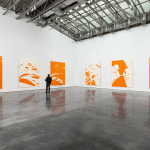“Christine Bailey: New Work,” curated by Jordan Faye Block. Corporate lobby at 100 East Pratt Street, Baltimore, MD.
Christine Bailey’s new work is painted in the style of one of Baltimore’s well-known painters, Cara Ober, who often blogs about the city’s scene. Bailey claims it’s a conceptual project about branding and originality, while angry Ober says it’s not fair. In the Washington Post, Blake Gopnik, friend of Bailey, explains that the single most important thing about Bailey’s new work is that it looks as though it might be new work by Cara Ober; Kriston Capps points out in the Washington City Paper that the exhibition’s original documentation failed to mention this conceptual spin. Annoyingly, Gopnik takes the opportunity to ridicule Ober’s work while defending Bailey. “Bailey’s paintings capture all of Ober’s telltale tricks and tics. Nostalgic imagery is pulled from older sources. Bird books, old encyclopedias, decorative wallpapers? Check. Tender, pastel colors — soft washes of pale yellows, blues and pinks — with brooding splashes of black on top? Check. Scraps of dictionary definitions, presented in old-timey fonts? Check. An overriding sense of capital-P Poetry, without ever making clear quite what that poetry’s about? Check.”However much the paintings might look like Ober’s, Bailey isn’t using that look to the same ends that Ober, or an Ober forger, would. Imitation may often be the sincerest form of flattery, but in this case it’s hard to imagine that a cerebral artist such as Bailey would like Ober’s work enough to want to truly claim it as her own. Bailey’s previous projects have included grabbing photographic faces off the Web, then paying craftsmen in China to do them up as oil portraits. Currently, at Baltimore’s School 33 Art Center, Bailey has ‘curated’ a show of three imaginary artists, of her own creation, one of whom exists only in the cyberworld of Second Life while another is based on Anna, Ikea’s automated online assistant.” Read more.
Apparently unsympathetic to appropriation (Mark Kostabi, Richard Prince,Sherry Levine, and the rest) Ober was outraged that someone had stolen her style, and she threatened to sue. You can read Bailey’s defense posted on Ober’s blog. “From what I’ve heard, people want to know why I chose Cara Ober’s work as my point of departure for this project. First of all, it was somewhat of an arbitrary decision; I could have worked in the style of any number of artists. Cara is someone I don’t know, so I had no personal connection and could be dispassionate about the work. Additionally, she and her paintings have a strong presence within the local art scene- analogous to a sort of ‘brand’ identity. Finally, it was important to me that I appropriated from someone whose work was already based in appropriation. I really had no personal agenda to do any harm to Cara.”
Kriston Capps points out how Bailey’s claim that she was exploring brand identity may be disingenuous, since the artist’s statement neglected to mention Ober, her work, or any reference to appropriation. “The original text that hung with the show made no reference to Ober’s work. In fact, it’s arguable that Bailey obscured the fact….Bailey didn’t mention Ober at all — not even in a roundabout fashion — until Ober threatened legal action. (Block has since posted a ‘clarification,’ a revised statement in which Bailey writes that she ‘used the work of Ms. Ober, among others, as a point of reference’ in pieces that adopted the notion of ‘designer replicas.’) ” Read more.






















